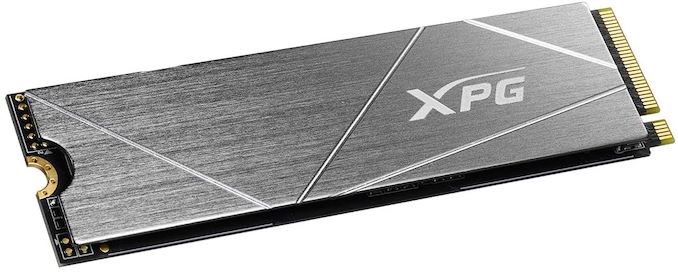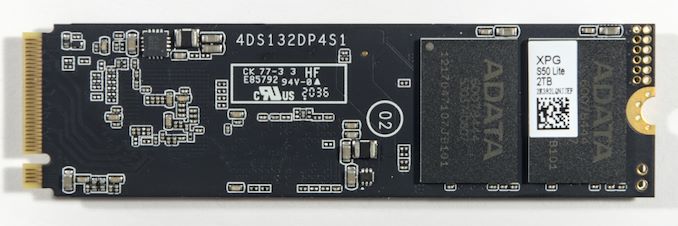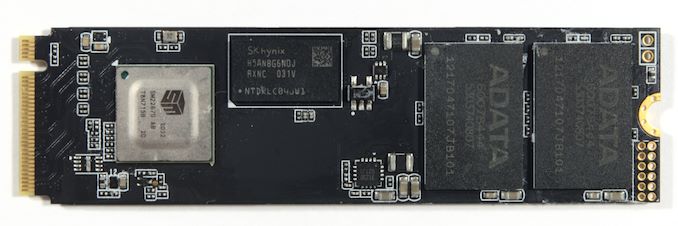The ADATA GAMMIX S50 Lite 2TB SSD Review: Mainstream PCIe Gen4
by Billy Tallis on April 30, 2021 8:00 AM EST
The roll-out of PCIe 4.0 support to consumer NVMe SSDs has been a long, drawn-out process so far, but it is progressing. Two waves of high-end SSDs have now hit the market, and last year we saw several brands introduce QLC-based SSDs using the now-outdated first-wave Gen4 SSD controller from Phison. More recently, PCIe 4.0 support has arrived for the mainstream mid-range market segment thanks to the ADATA XPG Gammix S50 Lite, based on the Silicon Motion SM2267 controller and TLC NAND flash memory.
The ADATA S50 Lite uses Silicon Motion's first PCie 4.0 SSD controller: the SM2267. Opting to start small, Silicon Motion has launched their mainstream SSD controller first, while their upcoming (overdue?) SM2264 will eventually be filling the high-end role.
To that end, the SM2267 serves Silicon Motion's lineup as a smaller, cheaper design aimed at mainstream consumer use cases. To accomplish this, Silicon Motion has built the SM2267 on a tried-and-true (and cheap) 28nm process and equipped the controller with 4 NAND channels, as opposed to the 12nm (or smaller) 8-channel controllers that are used in the latest high-end drives. This does limit maximum performance, but it also helps to keep costs in check, something that's especially useful during the current chip crunch.
Intel's recently-launched third generation QLC SSD (the Intel SSD 670p) uses a close relative of this controller; the SM2265 is an Intel-commissioned derivative of the SM2267 that lacks PCIe 4.0 support, but is otherwise identical in all the important ways. As we'll see from the S50 Lite's performance, the Intel 670p isn't missing out on much without that Gen4 support.
As for the subject of today's review, the ADATA XPG Gammix S50 Lite and its SM2267 controller is part of a growing trend of mainstream NVMe SSDs moving to 4-channel controllers rather than 8 channels. The capacity of individual NAND flash memory dies has grown to the point that an 8-channel controller is not necessary to get 2TB of flash connected, and the IO speed of recent generations of NAND flash is fast enough that a newer four-channel controller can match the performance of older 8-channel designs. This was first demonstrated to great effect by the SK hynix Gold P31. On paper, the Gammix S50 Lite promises more or less the same thing: performance that matches or slightly exceeds what we see from high-end PCIe Gen3 SSDs also using TLC NAND, despite working with half as many NAND channels.
| ADATA XPG Gammix S50 Lite Specifications | |||||
| Capacity | 512 GB | 1 TB | 2 TB | ||
| Form Factor | M.2 2280 double-sided with heatsink | ||||
| Interface | PCIe 4 x4, NVMe 1.4 | ||||
| Controller | Silicon Motion SM2267 | ||||
| NAND Flash | Intel/Micron 96L TLC | ||||
| DRAM | DDR4 | ||||
| Sequential Read (MB/s) | 3800 | 3900 | |||
| Sequential Write (MB/s) | 2800 | 3200 | |||
| Random Read IOPS (4kB) | 191k | 380k | 490k | ||
| Random Write IOPS (4kB) | 510k | 540k | |||
| Warranty | 5 years | ||||
| Write Endurance | 370 TB 0.4 DWPD |
740 TB 0.4 DWPD |
1480 TB 0.4 DWPD |
||
| Retail Price | $139.99 (14¢/GB) |
$235.99 (12¢/GB) |
|||
ADATA equips the S50 Lite with a fairly thick heatspreader, and like most of their Gammix SSDs, that heatspreader comes already attached to the drive rather than packaged separately as with their SX series drives. Instead of using their typical thermal paste, this heatspreader is attached with what is by far the most tenacious thermal tape we've ever encountered. It is reinforced with a tight-woven stiff fabric and the adhesive was strong enough that removing the heatspreader without permanently damaging the drive required copious use of solvents instead of just a bit of gentle prying.
So while we had originally speculated that the SM2267 controller might allow the S50 Lite to be the first Gen4 SSD suitable for laptop usage (hoping for similar power efficiency to the SK hynix Gold P31), this heatspreader plus the double-sided design means the S50 Lite will be a challenge to fit into some notebooks.
The SM2267 controller actually has a slightly higher pin count than the older 8-channel SM2262(EN) controllers, but the SM2267 uses denser packaging to fit in the same footprint as their earlier 4-channel SM2263 controller. The resulting PCB layout is not at all crowded, and could have easily been made into a single-sided design like the Intel 670p, had ADATA wanted to stack 16 NAND dies per package. Any future drives that use the DRAMless SM2267XT variant certainly should be single-sided.
Our 2TB S50 Lite sample is equipped with 1GB of DDR4 DRAM—half as much as we would typically expect from a mainstream or high-end SSD. As the high-end has moved on to PCIe Gen4, we have seen an increasing number of mid-range or low-end NVMe SSDs cut back from the usual 1GB per 1TB ratio of DRAM to NAND, and with the S50 Lite that trend has crossed over to Gen4. Having half or a fourth of the usual DRAM is nowhere near as serious a handicap as an entirely DRAMless SSD design, and will generally only make a difference for very storage-intense usage with heavy multitasking—workloads that are a bit beyond the intended use case for a drive like the S50 Lite.
Also noteworthy about the S50 Lite is that ADATA announced and published specs for a 512GB model, but we've only seen the 1TB and 2TB models hit the market.
The Competition
ADATA's original Gammix S50 was a Phison E16 drive: their first flagship Gen4 drive and part of the first wave of consumer Gen4 SSDs. That has since been superseded by the Gammix S70, and the S50 Lite slots into a lower position in their product stack. Standing in for the various Phison E16 TLC drives, we have test results from the Seagate FireCuda 520. We also have the Corsair MP600 CORE representing the Phison E16 QLC drive family.
Other PCIe Gen4 drives in this review include the WD Black SN850 and Samsung 980 PRO—both high-end models that are significantly more expensive.
The rest of the drives included in this review are a variety of more mainstream PCIe Gen3 SSDs and some relatively low-end NVMe options. Highlights include the Intel 670p (almost the same controller, but with QLC), the HP EX950 and Kingston KC2500 using the previous-generation SM2262EN controller, and Microcenter's Inland Premium representing the current crop of Phison E12S drives with TLC NAND and a reduced DRAM ratio.

















93 Comments
View All Comments
Oxford Guy - Friday, April 30, 2021 - link
'At least'? QLC is a downgrade, not an upgrade.Scour - Sunday, May 2, 2021 - link
Never wrote that the A400 was upgraded ;)Sorry, I´m not a native english speaking person
Tomatotech - Friday, April 30, 2021 - link
I've run an ADATA XPG SX8200 (non-pro) 1TB for the past 3+ years in my MacBook Pro as the system drive. Been very happy with it, and still blistering fast even now. Was approx 3x faster read & 4x faster write than the Apple OEM SSD, made a big difference to the feel of my MPB.As to changing components, not brilliant, but perhaps inevitable over the life of a long-lived model. Most SSD brands are not full-stack manufacturers, and supply / cost of sub-components is outside their control. As long as it meets the specs on the box and isn't crippled (like silently changing HDD models to HAMR mechanism without stating on the box).
Anandtech was quite accepting of companies changing SSD components on their middle-low end lines in the last SSD roundup. The 8200 Pro launched around 3 years ago, and while it's still damn fast for most people, I'd call it middle of the road now that PCIe 4.0 is here.
Scour - Friday, April 30, 2021 - link
I would prefer a new model-name if other components are used.MrCommunistGen - Friday, April 30, 2021 - link
+1They could easily have done this a number of ways:
1. add a letter to the end of the model with each rev, SX8200A, SX8200B
2. add Mk1, Mk2, etc.
3. increment the model number by +1 every time, SX8201, SX8202, etc
Each of these signify that it's still a related product aimed at the same market segment, while communicating that it isn't the exact same hardware that was reviewed when the product initially came out.
Scour - Sunday, May 2, 2021 - link
I still think the main reason is to use a model name which had good reviews.And maybe it costs 10 cents more/piece if you order new packages with a new model number
Oxford Guy - Friday, April 30, 2021 - link
And yet Intel, which was mentioned on the first page, has been at the forefront of pushing the anti-value QLC trash.Which would you rather choose? A company that is openly hostile to consume value or one that changes parts surreptitiously?
Nvidia is reportedly going to surreptitiously sell some 3060s with its latest anti-mining thing, without bothering to let consumers know which type they're getting for their money. Things like that should be illegal but the world is not governed adequately. Caveat emptor rules. The panel lottery for TVs is a huge example of the surreptitiousness fraud.
bji - Friday, April 30, 2021 - link
Holy crap man, will you get off of your anti-QLC rant already?Oxford Guy - Friday, April 30, 2021 - link
Ad hominem won't change reality. In reality, QLC offers only 30% more density for double the voltage states. That is diminished returns.Moreover, every dollar consumers spend on QLC reduces the price value of TLC by reducing TLC production.
I'm not sorry that I'm ruffling the feathers of various QLC-peddling corporations by posting the truth. Being attacked for it is hardly unexpected. It's how business communication works.
FunBunny2 - Friday, April 30, 2021 - link
"In reality, QLC offers only 30% more density for double the voltage states. That is diminished returns."IFF both TLC and QLC are on the same node size. moving back up to a larger node (and I know not whether that's happened) for QLC could (note the subjunctive) end up with an equivalent NAND density/bit. that, of course, should be the controlling factor.